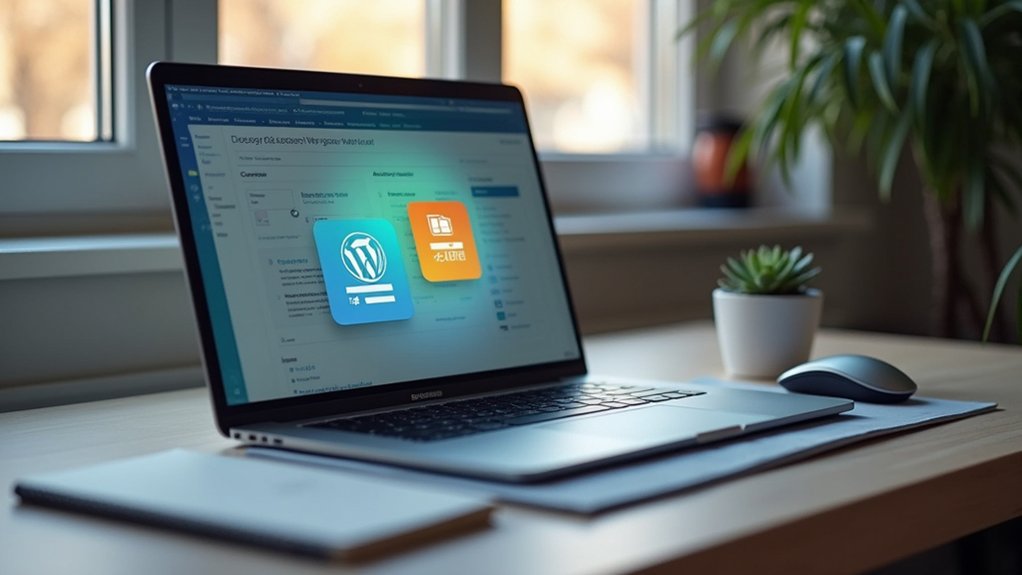WordPress offers extensive customization, making it challenging for beginners due to web hosting complexities and technical management. Mastery requires maneuvering its dashboard, selecting themes and plugins, enhancing site performance, and implementing robust security measures. Engaging with community resources and regular updates are vital to overcoming the learning curve. Essential tools like page builders and SEO plugins can simplify tasks. For in-depth insights and practical tips, further exploration can enhance one’s proficiency.
Key Takeaways
- WordPress has a steep learning curve for beginners due to web hosting and technical management requirements.
- The open-source framework of WordPress offers extensive customization and flexibility, making continuous learning essential.
- Page builders like Elementor provide a user-friendly drag-and-drop interface, simplifying content creation for beginners.
- Community resources such as forums and blogs offer valuable support and guidance for mastering WordPress.
- Regular updates and maintenance are crucial for optimal site performance and security, reducing learning challenges over time.
Understanding WordPress as a Content Management System
As a self-hosted content management system (CMS), WordPress serves as a robust platform for building and managing digital content across diverse applications such as blogs, portfolios, and e-commerce sites.
WordPress as a content management system powers approximately 43% of all websites globally, underscoring its adaptability and widespread appeal.
However, the learning curve can be steep for beginners due to the necessity of independently securing web hosting services and managing technical aspects like updates and security.
Navigating WordPress requires mastering independent web hosting and managing updates and security.
Its open-source framework provides extensive customization options through an expansive repository of themes and plugins, offering advanced users the flexibility to tailor their sites intricately.
Nevertheless, the abundance of choices can overwhelm newcomers, emphasizing the importance of continuous learning and resource utilization to harness its full potential.
The WordPress dashboard stands as a vital interface for site management, offering users streamlined access to essential components through its left sidebar navigation menu. This centralized control panel facilitates efficient content creation by providing quick access to posts, pages, media, comments, and settings.
The top bar enhances usability with shortcuts to the site’s frontend and options for initiating new posts or pages. At the core of content creation is the Gutenberg editor, which employs customizable blocks to craft visually compelling layouts sans code.
Users can organize content effectively by managing categories and tags, enhancing SEO and navigation. In addition, the dashboard’s media library enables the uploading and optimizing of media files, essential for maintaining superior website performance and search engine optimization.
Choosing the Right Themes and Plugins
When starting on the process of theme and plugin selection for a WordPress site, it’s imperative to evaluate the pivotal role these elements play in defining both the aesthetic and functional dimensions of a website. Selecting the right theme is vital, with over 13,000 free WordPress themes available. Factors such as mobile responsiveness, e-commerce capabilities, and compatibility with page builders are paramount when choosing a theme. On the plugin front, over 59,000 options exist. Installing a plugin should be approached with caution; excessive use can hinder performance. Prioritizing multifunctional plugins and researching their reputation is indispensable.
| Key Considerations | Recommendations |
|---|---|
| Theme Selection | Use reputable providers like Astra |
| Plugin Management | Limit installations, prioritize quality |
| Compatibility & Features | Confirm mobile and builder compatibility |
Overcoming the Learning Curve
After selecting appropriate themes and plugins, the next challenge for users is maneuvering the WordPress learning curve, a process that ranges from mastering basic functionalities to executing advanced customizations.
Learning WordPress efficiently requires strategic planning and utilizing the abundant resources available online. Resources such as WPBeginner and LinkedIn Learning offer structured tutorials that cater to various proficiency levels, effectively aiding in overcoming the learning curve.
Strategic planning and online resources are key to efficiently mastering WordPress.
- Engage with the Community: Forums and Facebook groups provide practical support and solutions to common issues.
- Utilize Managed Hosting Services: These services streamline setup with one-click installations, reducing backend complexity.
- Set Achievable Goals: Practicing in a local development environment can build confidence and reinforce learning concepts.
Essential Tools for Simplifying WordPress
For individuals seeking to streamline their WordPress experience, utilizing essential tools can greatly ease the development process.
Managed WordPress hosting services, such as Hostinger, offer configurations optimized for WordPress, reducing backend complexities with features like one-click installations and pre-installed themes.
Essential plugins, including WPForms for forms, AIOSEO for SEO optimization, and Duplicator for backups, enhance site functionality without requiring coding expertise.
Additionally, page builders like Elementor and SeedProd provide intuitive drag-and-drop interfaces, enabling users to design websites efficiently with minimal technical know-how.
To further simplify learning, platforms such as WPBeginner and LinkedIn Learning offer extensive resources—tutorials, guides, and videos—essential for mastering WordPress.
Engaging with the WordPress community also offers valuable support and insights.
Maximizing Site Customization With Page Builders
In the domain of WordPress customization, page builders like Elementor and Divi provide unparalleled drag-and-drop flexibility, enabling users to construct complex layouts without engaging in extensive coding practices.
These tools enhance design efficiency by offering an array of pre-designed templates and modular blocks, which streamline the integration of essential website components such as contact forms and media galleries.
Additionally, page builders’ capabilities extend to responsive design configurations and custom CSS implementation, thereby optimizing both aesthetic and functional aspects of a site.
Drag-and-Drop Flexibility
Frequently lauded for its intuitive design capabilities, the drag-and-drop flexibility of WordPress page builders like Elementor and Beaver Builder revolutionizes site customization.
By enabling users to design visually without coding expertise, these tools democratize web development. The integration of the WordPress block editor enhances this experience, allowing seamless content creation through customizable blocks.
Page builders offer pre-built templates, aiding beginners in the design process, and include responsive design features to guarantee peak display across devices.
Key Advantages of Drag-and-Drop Flexibility
- Real-Time Editing: Adjust settings and preview changes instantaneously, facilitating dynamic customization.
- Pre-Built Elements: Utilize templates and sections to expedite the design process, reducing time and effort.
- Responsive Design: Ensure compatibility across diverse devices without additional coding, maintaining design integrity.
Enhancing Design Efficiency
While the digital environment constantly evolves, WordPress page builders like Elementor and SeedProd greatly enhance design efficiency, empowering users to achieve sophisticated site customization with ease.
These page builder plugins offer intuitive drag-and-drop interfaces, enabling complex layouts without coding expertise. By utilizing pre-made templates and blocks, users can accelerate the design process, customizing existing structures rather than initiating from zero.
The WordPress block editor complements these tools, facilitating flexible content creation with diverse block options, streamlining page and post design.
Additionally, advanced features such as responsive design controls guarantee cross-device optimization, eliminating the need for separate mobile themes.
Page builders also enhance site performance through incorporating built-in optimization capabilities, loading only essential scripts, thereby boosting loading speed and overall user experience.
Strategies for Effective SEO Implementation
To effectively implement SEO strategies within WordPress, one must optimize on-page elements such as meta tags, headers, and keyword density, ensuring alignment with search engine algorithms.
Utilizing advanced SEO plugins like All in One SEO (AIOSEO) facilitates real-time optimization suggestions and site score analysis, enhancing site visibility and performance metrics.
Optimize On-Page Elements
Optimizing on-page elements is pivotal for enhancing SEO performance and guaranteeing a website’s visibility in search engine results.
WordPress users can leverage SEO basics to optimize title tags by adhering to character limits and incorporating primary keywords, thereby improving search visibility and click-through rates.
Additionally, structuring content with hierarchical header tags (H1, H2, H3) facilitates search engines in comprehending key topics and enhances user readability.
- Keyword Integration: Seamlessly embed relevant keywords within the first 100 words of content to signal thematic relevance to search engines.
- Image Optimization: Employ descriptive alt text with keywords for images to bolster indexing and accessibility.
- Loading Speed: Optimize images and implement caching strategies to guarantee the site loads in under 3 seconds, retaining visitor engagement.
Leverage SEO Plugins
Numerous WordPress users can enhance their site’s search engine optimization through utilizing advanced SEO plugins. Tools like All in One SEO (AIOSEO) offer thorough on-page optimization features, including XML sitemap generation and meta tag management, without necessitating extensive technical knowledge.
AIOSEO’s capabilities extend to local SEO and eCommerce, facilitating targeted audience engagement. Simultaneously, plugins such as MonsterInsights provide robust website analytics, enabling users to make informed, data-driven decisions to refine their SEO strategy.
These plugins offer real-time optimization insights and monitor the SEO Site Score, essential for maintaining visibility. Regular updates and configurations of these SEO plugins are imperative, as outdated software may introduce vulnerabilities, thereby adversely affecting search engine rankings and compromising site efficacy.
Enhancing Site Performance and Speed
Enhancing site performance and speed is paramount in the digital environment, where milliseconds can greatly impact user engagement and conversion rates.
Performance optimization in WordPress involves several advanced techniques to guarantee site speed is maximized. Utilizing WordPress plugins like WP Super Cache or W3 Total Cache can considerably reduce load times by delivering pre-rendered static content.
Image compression tools, such as Smush and TinyPNG, are essential for reducing file sizes without degrading quality, which further accelerates loading times.
Additionally, implementing a Content Delivery Network (CDN) like Cloudflare distributes content across geographically diverse servers, minimizing latency and enhancing global access.
- Caching Plugins: Serve static content to improve speed.
- Image Compression: Decrease file sizes without quality loss.
- CDN Implementation: Reduce latency for distant users.
Ensuring Robust Security Measures
Guaranteeing robust security measures in WordPress involves deploying essential security plugins, such as Sucuri, to monitor and protect against vulnerabilities and malware.
Implementing SSL certificates is critical for encrypting data transmission, thereby enhancing user trust and adhering to data protection standards.
Regular security audits should be conducted to proactively identify potential threats and guarantee compliance with the latest security protocols.
Essential Security Plugins
Security plugins form the cornerstone of a robust defense strategy for WordPress sites, offering a suite of tools designed to mitigate potential vulnerabilities.
Essential features of security plugins include malware scanning, firewall protection, and activity monitoring. By integrating such plugins, a WordPress site can effectively safeguard against unauthorized access and cyber threats.
Key plugins include:
- Sucuri: Provides thorough monitoring, malware scanning, and alert notifications, making it indispensable for maintaining site integrity.
- Wordfence: Offers advanced firewall protection, malware detection, and real-time traffic analysis to prevent breaches.
- iThemes Security: Implements over 30 security measures including two-factor authentication and brute force protection, enhancing overall site security.
Regular updates are imperative to maintain these defenses, as outdated plugins can expose sites to exploitable vulnerabilities.
Implementing SSL Certificates
Implementing SSL certificates is a fundamental aspect of bolstering a website’s security infrastructure, as it encrypts data interactions between the server and client, thereby safeguarding sensitive user information.
SSL certificates are integral to website security, ensuring that login credentials and payment details remain confidential.
In WordPress maintenance, integrating SSL is essential not only for protection but also for enhancing search engine optimization. Google’s algorithms favor HTTPS-secured sites, potentially boosting traffic and visibility.
Web hosting providers often facilitate this process by offering free SSL certificates through platforms like Let’s Encrypt, making implementation accessible.
Monitoring the certificate’s validity is critical, as expired SSL certificates can trigger security alerts, diminishing user trust.
Verifying implementation is simple—look for a padlock icon in the browser’s address bar.
Regular Security Audits
Conducting regular security audits is a critical component of maintaining a secure WordPress environment. These audits are essential for identifying vulnerabilities, especially in outdated plugins and themes which hackers often target.
Utilizing advanced security plugins such as Sucuri automates this process, offering real-time monitoring and alerts for potential breaches or malware.
Key steps in a thorough audit include:
- User Account Management: Scrutinize user accounts for unauthorized access, enforce strong password policies, and eliminate unused accounts to mitigate risk.
- Backup Strategies: Implement regular backups to guarantee swift recovery in case of a security breach, minimizing data loss and downtime.
- Adherence to Security Best Practices: Apply security best practices, including SSL certificates and security headers, to fortify defenses during audits.
These measures collectively enhance the robustness of WordPress security frameworks.
Leveraging Community Resources and Support
While steering through the intricacies of WordPress, utilizing community resources and support proves invaluable for users at all proficiency levels. Community resources such as forums and blogs offer WordPress tutorials that provide support and guidance on diverse topics, from installation to advanced customization.
Platforms like WPBeginner and WP101 equip beginners with foundational knowledge, while the Gutenberg Handbook serves as a technical manual, elucidating the block editor’s nuanced functionalities. Engaging in community groups, particularly on Facebook, facilitates experience-sharing and feedback exchange among novice and seasoned users.
Additionally, local WordPress meetups and workshops present opportunities for immersive, hands-on learning experiences, enhancing one’s technical prowess through direct interaction with fellow users and developers. These collective resources empower users to navigate WordPress’s complexities effectively.
Best Practices for Regular Maintenance and Updates
Guaranteeing ideal performance and security of a WordPress site requires adherence to best practices for regular maintenance and updates.
Regular maintenance encompasses several critical tasks to keep the site secure and efficient.
- Core, Theme, and Plugin Updates: Consistent updates of the WordPress core, themes, and plugins are essential to patch vulnerabilities and enhance functionality, protecting against potential threats from outdated versions.
- Security Plugin Utilization: Employing a security plugin such as Sucuri enables proactive monitoring of site activities, automated malware scans, and real-time alerts, fortifying the site against cyber threats.
- Regular Backups: Implementing automated backup schedules with tools like Duplicator Pro guarantees data integrity and availability, allowing for swift restoration in cases of data breaches or loss.
These practices collectively reinforce a site’s robustness and reliability.
Frequently Asked Questions
How Difficult Is Wordpress to Learn?
Mastering WordPress basics involves a straightforward user experience, enhanced by abundant learning resources. However, proficiency in advanced techniques demands technical proficiency, as customization and development require deeper understanding beyond initial setup and maneuvering pre-built themes and plugins.
How Many Days Will It Take to Learn Wordpress?
The learning pace for WordPress varies; basic site setup and post publishing can be achieved in three days. Utilizing beginner resources and focusing on skill progression with advanced techniques, mastering complex features could span several months.
Why Is Wordpress so Complicated to Use?
WordPress presents user interface challenges, plugin management issues, and theme customization complexities due to its decentralized ecosystem. Steering through its extensive options demands technical proficiency, as users must master different interfaces, resolve compatibility conflicts, and manage diverse customization techniques.
Is Wordpress Easy to Navigate?
WordPress’s user interface design, featuring intuitive navigation menus and an adaptive dashboard, enhances user experience. The dynamic work area and customizable options enable seamless navigation, facilitating efficient management for users with varying levels of technical proficiency.
Conclusion
In mastering WordPress, users traverse an environment rich with technical nuances and industry-specific methodologies. The complexities of theme and plugin integration, coupled with performance optimization and security protocols, present an initial learning curve. However, utilizing community resources and employing advanced tools can greatly streamline the process. Regular maintenance and strategic updates are imperative for sustained functionality and security. Ultimately, with diligence and continued engagement with evolving best practices, WordPress becomes an accessible and robust content management solution.




